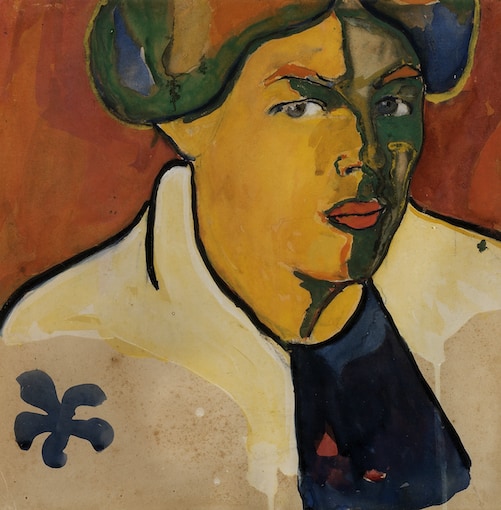En cours
A Venir
Billetterie
Collections en ligne
Actualités
Boutique
Restaurants et privatisation


The Russian artists of the twentieth century were initially inspired by the European avant-garde: Cubism and Futurism. From this movement, they developed an original interpretation, and then, buoyed by the effervescence and utopian spirit of the revolution, they developed radically new forms of artistic research. The Stalinist dictatorship, by imposing the dogma of socialist realism from 1932 onwards, consigned them to silence and obscurity.
The Russian avant-garde, a period that was gradually rediscovered in the 1970s, has often been presented in the West in a simplified, schematic form, focusing only on Suprematism. For example, Malevich is heralded as an emblematic figure, as are some of his disciples (Popova, Klioune). Moreover, the Constructivist movement, initiated by Rodchenko, Tatlin and Lissitzky, set out to abolish the autonomy of art and take over all areas of everyday life, from architecture and the applied arts to posters and photography.
The great merit of the Costakis collection, apart from its exceptional richness, is that it demonstrates the diversity of a multi-faceted avant-garde, in which the main movements – cubo-futurism, suprematism and constructivism – appear more open and fluid than we could have imagined, and the personal trajectories more convoluted. This collection also reveals secondary artistic periods and little-known artists, such as the “organicism” of Matiouchine and Ender, the “electro-organism” of Redko, the “analytical art” of Filonov and Samuilo, and the critical figuration of Nikritin.
The exhibition explores how Russian artists of the 1920s anticipated, through surprising works of art, the artistic research that developed after the war in the West by American abstract expressionism, French lyrical abstraction, and even minimalism and new figuration.
The Russian artists of the twentieth century were initially inspired by the European avant-garde: Cubism and Futurism. From this movement, they developed an original interpretation, and then, buoyed by the effervescence and utopian spirit of the revolution, they developed radically new forms of artistic research. The Stalinist dictatorship, by imposing the dogma of socialist realism from 1932 onwards, consigned them to silence and obscurity.
The Russian avant-garde, a period that was gradually rediscovered in the 1970s, has often been presented in the West in a simplified, schematic form, focusing only on Suprematism. For example, Malevich is heralded as an emblematic figure, as are some of his disciples (Popova, Klioune). Moreover, the Constructivist movement, initiated by Rodchenko, Tatlin and Lissitzky, set out to abolish the autonomy of art and take over all areas of everyday life, from architecture and the applied arts to posters and photography.
The great merit of the Costakis collection, apart from its exceptional richness, is that it demonstrates the diversity of a multi-faceted avant-garde, in which the main movements – cubo-futurism, suprematism and constructivism – appear more open and fluid than we could have imagined, and the personal trajectories more convoluted. This collection also reveals secondary artistic periods and little-known artists, such as the “organicism” of Matiouchine and Ender, the “electro-organism” of Redko, the “analytical art” of Filonov and Samuilo, and the critical figuration of Nikritin.
The exhibition explores how Russian artists of the 1920s anticipated, through surprising works of art, the artistic research that developed after the war in the West by American abstract expressionism, French lyrical abstraction, and even minimalism and new figuration.
The Russian artists of the twentieth century were initially inspired by the European avant-garde: Cubism and Futurism. From this movement, they developed an original interpretation, and then, buoyed by the effervescence and utopian spirit of the revolution, they developed radically new forms of artistic research. The Stalinist dictatorship, by imposing the dogma of socialist realism from 1932 onwards, consigned them to silence and obscurity.
The Russian avant-garde, a period that was gradually rediscovered in the 1970s, has often been presented in the West in a simplified, schematic form, focusing only on Suprematism. For example, Malevich is heralded as an emblematic figure, as are some of his disciples (Popova, Klioune). Moreover, the Constructivist movement, initiated by Rodchenko, Tatlin and Lissitzky, set out to abolish the autonomy of art and take over all areas of everyday life, from architecture and the applied arts to posters and photography.
The great merit of the Costakis collection, apart from its exceptional richness, is that it demonstrates the diversity of a multi-faceted avant-garde, in which the main movements – cubo-futurism, suprematism and constructivism – appear more open and fluid than we could have imagined, and the personal trajectories more convoluted. This collection also reveals secondary artistic periods and little-known artists, such as the “organicism” of Matiouchine and Ender, the “electro-organism” of Redko, the “analytical art” of Filonov and Samuilo, and the critical figuration of Nikritin.
The exhibition explores how Russian artists of the 1920s anticipated, through surprising works of art, the artistic research that developed after the war in the West by American abstract expressionism, French lyrical abstraction, and even minimalism and new figuration.
Multimédia
Teaser
The Russian Avant-Garde in the Costakis Collection
Mentions légales | CGU | Données personnelles | Gestion des cookies
Musée Maillol, 2021
Mentions légales | CGU | Données personnelles | Gestion des cookies
Musée Maillol, 2021